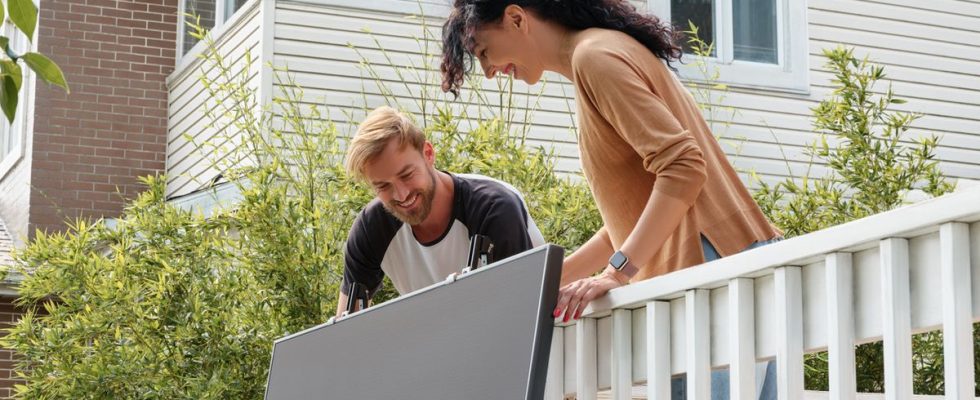Produce part of your electrical energy using photovoltaic panels, even if you live in an apartment? Owners or tenants, a new solution is emerging on your balcony or terrace: PowerStream. Launched by EcoFlow, this ingenious device that combines solar panels and a storage system would save between 250 euros and 415 euros per year on its electricity bill. To know more, 20 minutes asked Joël Cibil Le Meudec, France director of EcoFlow.
Up to 800 W of electricity
There was a time when satellite dishes flourished on balconies. Sign of time, it is the photovoltaic panels which could well be invited to the frontages of the buildings with the PowerStream device of EcoFlow. Created in 2017, this company initially specialized in batteries, wishes to meet the growing demand of the public to produce all or part of its electricity thanks to solar energy.
In one year, the number of French people producing their own electrical energy using photovoltaic panels would have jumped by +64%. 150% in two years… But only homeowners had access to it until then. “Rooftop solar panels are often expensive and unsightly, PowerStream’s idea is to allow everyone, owners or tenants, in a house or apartment, to produce up to 800 W of electricity with a mobile solution, which can also operate in the evening thanks to a battery which will have stored current during the day”, explains Joël Cibil Le Meudec, EcoFlow’s France director.
Day and night
PowerStream consists of two rigid solar panels of 400 W each to hang with a dedicated system; a micro-inverter to be connected to the mains which redistributes the current produced in the domestic network; two connected sockets; as well as a 2 kWh portable battery. A flat cable, which can pass under a window, connects the panels to the inverter, which can thus be housed inside. The advantage of this device is twofold.
First, it produces up to 800 W during the day (if perfectly oriented towards the sun). PowerStream can thus cover many needs, in particular those of all our constantly connected equipment (refrigerator, freezer, computer if we telework), and those of appliances on standby. These needs can be assessed between 200 and 300 W continuously. “In the event of energy consumption greater than that produced, the traditional network takes over,” reassures the director of EcoFlow.
Then, the energy produced and not consumed during the day does not return to the network (even if it could be resold to the supplier), but is stored in the battery. No unnecessary production! Which battery (with a capacity of 2048 Wh) will be able to deliver its electricity in the evening and at night, when the electricity production of the photovoltaic panels is zero. It has a 230 W socket for this; one of 12V; two USB-A ports and two USB-C ports. More than enough to connect your television and binge watcher at nightfall his television series while recharging the smartphones of the house. But not necessarily enough to power hotplates, the oven or the washing machine in the evening.
The battery that makes the difference
Good point however: this battery is transportable. Admittedly, it weighs 23 kg (the weight of a big scooter), but you can move it and, why not, take it with you to the campsite this summer (or in your van for a roadtrip!). And this battery makes all the difference compared to other systems based on simple photovoltaic panels.

As for the connected sockets provided, they allow, via the manufacturer’s application, to control remotely or by programming them, the devices associated with them, but also to allocate the solar energy produced to them. It is thus possible to give priority to supplying a device with free electricity and avoid drawing paid electricity from the network. So save money.
Compared to average electricity consumption, and depending on the price per kilowatt hour paid (from 20 to 40 euro cents), the savings promised by PowerStream could reach between 250 and 415 euros.
Tempting? Yes, but before investing 2,671 euros in the EcoFlow PowerStream kit, it is still necessary to first be well documented. “This kit aims to compensate for the basic and standby consumption of the house, not to contribute to the active consumption of the house”, recalls Joël Cibil Le Meudec, France director of EcoFlow. Even if 800 watts of electricity produced (maximum) are far from negligible.
Be careful also not to electrify your neighbours: it is necessary to inquire and request the necessary authorizations from the copro, or even the municipality, before hanging solar panels (even if they are removable) on your balcony.

